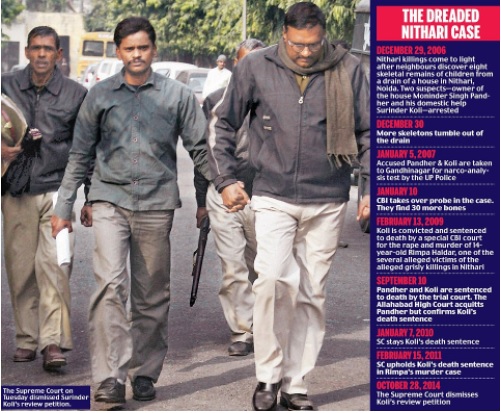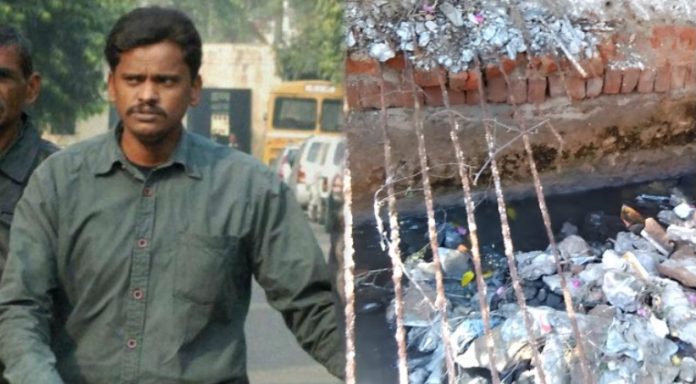In this article, Jagriti Bharti of Amity Law School, Lucknow gives an overview of the infamous Nithari case.
Nithari case is one of the most horrifying and gruesome cases of 2006. Nithari is a village situated in Noida (Delhi). This case involved the commission of heinous crimes like sexual abuse, murder, cannibalism and attempted necrophilia. The case grabbed headlines in media due to its brutal and rare nature of crimes. The case came to light after a continued series of disappearances of the children (both boys and girls) and teenagers from the Nithari village in the year 2005 and 2006. Investigation of this case ultimately lead to tracing of the bungalow of Moninder Singh Pandher and this caused the disappearance mystery of the Nithari village to unfold one step after the another.
Background
Year 2003
An abnormally high number of women and children were reported to be missing from Sector 31 of the Nithari village in Noida. The fact of women and children missing from the village predated Surinder Koli’s arrival as a domestic servant of Moninder Singh Pandher who was a businessman and the owner of the bungalow number D-5 located in Sector 31 of the Nithari village. Numerous missing reports were filed to the police by the families of the victim but no action was taken.
February 2005
14 year-old-girl named Rimpa Haldar went missing from 8 February 2005. Her parents made several attempts to register a missing report of her daughter with police but were unsuccessful.
March 2005
Some boys playing cricket found a hand in the plastic bag in the drain located behind D-5. The matter was informed to the police who declaring the hand as an animal carcass, asked the villagers to forget about the incident as nothing was wrong. This can be confirmed by the statements of prosecution witness 23[1] and 24[2] which are available as evidence in the court records.
Facts of the case
- On 7 May 2006, a girl named Payal informed her father Nand Lal about her going to Moninder Singh Pandher bungalow but after that, she went missing. Her father went to search her in D-5 where Pandher lived with his servant Koli. Pandher was not in Noida that day and Koli denied knowing anything about Payal.
- Nand Lal went to the police to register a complaint of his missing daughter but police refused to register his complaint. Tired of visiting police and Pandher for one month, he approached the then Noida SSP on June 2006 for help.
- On the order of the SSP, police registered Nand Lal’s complaint of his missing daughter and started their investigation. Police were able to find the fact that Payal’s mobile phone was still in use and traced its location. Checking the call details of the Payal’s number lead them to Koli who called her a day before she went missing.
- Police arrested Koli for further investigation but Pandher got him released soon. Police was not able to find out anything remarkable which could guide them to the whereabouts of Payal but the involvement of Koli in the case was evident.
- Upset with the police’s investigation on the case, Nand Lal approached the court on 7 October 2006. The court ordered the police to investigate the case. On investigation, police discovered lots of plastic bags filled with human skeletons from the drain located behind the bungalow.
- Bungalow owner Pandher and his servant Koli got arrested on 29 December 2006. More skeletons were excavated from the drain on 30 December 2006. Not much evidence was found against both the suspects.
- Mere discovery of skeletons was not sufficient to prove them murders. But the discovery created a sensation in the whole country and people started demanding justice.
- Investigation of the Payal’s case open up the facts of disappeared children and teenager of Nithari. Pressurised with the public rage, Uttar Pradesh government handed over the case to the CBI on 11 January 2007.
Koli’s Confession
CBI was unable to find any evidence against Koli even after 60 days of police custody. They applied to the Magistrate to have Koli’s confession recorded on 27 February 2007 stating that he was willing to confess. Koli’s confession was recorded by the magistrate. In his confession, Koli gave a detailed account of how he lured the victims (9 female children, 2 male children and 5 adult women) into the house, murdered them and attempted to have sex with inert bodies, chopped the dead bodies, eat their body parts and threw the remains in the drain at the back of the bungalow.
According to his confession, Koli was a servant at Pandher’s house. Pandher used to live alone in the bungalow and his family resided at Chandigarh. Apart from them, there was another domestic servant named Maya Sarkar, a gardener and two drivers employed by Pandher in his house. All the murders were done by Koli in the drawing room between 9 am to 4 pm. After each killing, he would carry the body upstairs to a bathroom and chop it into small parts. He would leave the bathroom in that condition and only after cooking some of the body parts and eating them, he would clean up the bathroom and drawing room. It is very hard to believe that not once in any of the murder, neither Pandher nor any other person employed by him noticed all these things. None was tried as a witness at trial.
THE MINISTRY OF WOMEN AND CHILD DEVELOPMENT REPORT
In 2007, the WCD set up an expert committee to investigate the Nithari case. Their report is an indictment of Noida police and CBI’s investigation. Dr Vinod Kumar (the Chief Medical Superintendent, Noida) informed the committee that the surgical precision with which the bodies were cut create suspicion of organ trade. The WCD report casts doubt that organ trade can be the motive of the offence.
Observation of the Expert Committee
After going through the investigation report provided by the district authorities, the expert committee observed that the modus operandi and motive of the murder were not clear. Following are the observations made by the committee in the case:
- No type and pattern of choice in the selection of the victim which is the hallmark of a serial killer.
- Drain behind and at front of the house is not too deep and has stagnant water. Disposed bodies would have remained there. It’s strange that there was no complaint of foul smell due to decomposition.
- Accused himself confessed that the murder was committed during the daytime. It’s strange that no one witnessed the disposal of the bodies.
- To a body to get decomposed, it normally takes 3 years. Deaths were as recent as 2006 yet only bones and skull was found.
- Torsos were disposed of separately by the accused which was discovered only after search carried out under the supervision of the CBI.
Suggestions of the committee
- CBI should look into angles into organ trade, sexual exploitation, and forms of crimes against women and children.
- Need to study records of organ transplant of all the hospitals of Noida to trace the donor and the recipient.
- The discovery of more and more bodies creates a suspicion of involvement of some other person in the case. To know the motive and modus operandi of the case, the involvement of other persons needs to be investigated.
Judgment
The timeline of the Nithari case will give a better insight into the proceedings and judgement of the case till now-
Year 2006
December 29: Nithari case came into light with the discovery of skeletons from the drain located behind the bungalow number D-5 of Sector 31 in Nithari village of Noida. The owner of the house Moninder Singh Pandher and his servant Surinder Koli were arrested as the prime suspect.
December 30: More skeletons were discovered from the drain.
December 31: Two police constables were suspended for negligence in their duty.
Year 2007
January 3: Uttar Pradesh government suspended[3] –
- The then SSP ‘Piyush Mordia’ (Gautam Buddh Nagar district)
- The then additional SP of Noida ‘Saumitra Yadav’.
- Former circle officer ‘Sewak Ram Yadav’.
- 6 suspended sub inspectors were dismissed.
January 5: Pandher and Koli were taken to Gandhinagar for extensive narco analysis test by U.P. police.
January 10: CBI took over the case for investigation.
January 11: First CBI team visits Nithari for investigation. 30 more bones found near Pandher’s bungalow.
January 12: Pandher and Koli interrogated by the CBI.
January 20: UP government filed a report to NHRC.
February 8: Pandher and Koli sent to 14 days of CBI custody by Special CBI court.

Year 2009
February 13: Koli was awarded death sentence by the Special CBI court for rape and murder of Rimpa Haldar, one of the several victims.
September 10: Pandher and Koli were awarded death sentence by the trial court. The Allahabad High Court acquitted Pandher but confirmed Koli’s death sentence.
Year 2010
January 7: Supreme Court stayed the death sentence of Koli.
Year 2014
July 20: Mercy petition of Koli was rejected by the former President Pranab Mukherjee.
September 8: Court stayed Koli’s execution at 01 am at night. He was to be hanged on September 12 in Meerut jail.
September 12: The Supreme court extended the interim stay on execution of Koli till October 29.
October 28: The Supreme court bench headed by the CJI, H.L. Dattu rejected the review petition stating that the court did not commit any error in its judgement.
Year 2015
January 29: A division bench comprising CJ Chandrachud and Justice Baghel held execution of Koli’s death sentence. The reason stated by them was, “it would be unconstitutional in view of the inordinate delay in deciding mercy petition.”
The order came after a PIL filed by an NGO named ‘People’s Union for Democratic Rights whose contention was that the period elapsed in the disposal of Koli’s mercy petition was three years and three months and execution of death sentence would be in violation of Article 21 of the Constitution.
Year 2017
July 22: CBI convicted Pandher and Koli and said that the sentence will be pronounced on July 24.
July 24: Pandher and Koli awarded death sentence by CBI rape and murder in Pinky Sarkar case.
This is the eighth of the 16 murder cases in which the judgement has been delivered in Nithari case. Judgments on other eight cases are yet to be delivered. It has been almost eleven years since the case first came into light and families are still waiting for the justice…
References
[1] http://www.indiaresists.com/wp-content/uploads/2014/11/Annexure-I-Evidence-of-PW-23.zip
[2]http://www.indiaresists.com/wp-content/uploads/2014/11/Annexure-II-Evidence-of-PW24.zip
[3]http://www.hindustantimes.com/india/timeline-nithari/story-CghmTmuSCYbSI2SJgNSNJN.html
 Serato DJ Crack 2025Serato DJ PRO Crack
Serato DJ Crack 2025Serato DJ PRO Crack









 Allow notifications
Allow notifications


